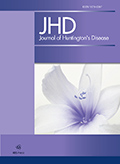Authors: Dinesh, Karthik | Snyder, Christopher W. | Xiong, Mulin | Tarolli, Christopher G. | Sharma, Saloni | Dorsey, E. Ray | Sharma, Gaurav | Adams, Jamie L.
Article Type:
Research Article
Abstract:
Background: Most current measures of Huntington’s disease (HD) motor symptoms are subjective, categorical, and limited to in-person visits. Wearable sensors enable objective, frequent, and remote data collection in real-world settings. However, longitudinal sensor studies in HD are lacking. Objective: To measure motor symptoms of HD using wearable sensors in a longitudinal study. Methods: Participants with HD, prodromal HD, and without a movement disorder wore five accelerometers, one on each limb and on the trunk, at up to four clinic visits over one year. After each visit, participants wore the sensors at home for two days. Based
…on the accelerometer data from the trunk, we calculated a “truncal Chorea Index” for periods when the participant was sitting. We also measured gait parameters and activity profiles. To measure group differences, track progression, and observe individual variability, statistical analysis of the data was conducted using a linear mixed-effects model. Results: Fifteen individuals with HD, five with prodromal HD, and 19 controls were enrolled. The average truncal Chorea Index was higher in individuals with HD (26.6, p < 0.001) than in controls (15.6). For participants with HD, the truncal Chorea Index showed a high intra-day variability but minimal change over 12 months. Individuals with HD walked less (HD = 3818, prodromal HD = 6957, controls = 5514 steps/day) and took longer duration steps (HD = 0.97, prodromal HD = 0.78, controls = 0.85 seconds/step) than the other groups. Individuals with HD spent over half their day lying down (HD = 51.1%, prodromal HD = 38.0%, controls = 37.1%). Conclusions: A novel truncal Chorea Index can assess truncal chorea at home, finds substantial variability, and suggests that truncal chorea may be present in prodromal HD. Individuals with HD walk less and slower and spend more time lying down than controls. These findings require additional investigation, could inform clinical care, and could be used to evaluate new therapies.
Show more
Keywords: Huntington’s disease, chorea, motor activity, gait, wearable electronic
devices, walking speed
DOI: 10.3233/JHD-190375
Citation: Journal of Huntington's Disease,
vol. 9, no. 1, pp. 69-81, 2020
Price: EUR 27.50





